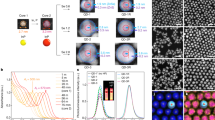Abstract
For more than two decades, research interest has been focused on groups II–VI of quantum dots (QDs) because of their potential applications in lasers, light-emitting diodes, and biological imaging. Given the highly intrinsic toxicity of cadmium, the biological applications of Cd-QDs have been limited. The European Union prohibits the use of Cd-QDs in electronic devices by 2017 (Anc et al. in ECS J Solid State Sci and Technol 2:R3071, 2013 [1]. This problem is addressed by developing Cd-free QDs. Groups III–V QDs exhibit narrow full width at half maximum compared with other Cd-free QDs, such as CuInS2, and are suitable for backlight units. With increasing number of related publications, the main attraction to these semiconductors focuses on the robustness of the covalent bond in groups III–V semiconductor materials rather than the ionic bond in groups II–VI semiconductors. Moreover, the covalent bond can enhance the stability of Cd-free QDs. Indium phosphide (InP) core easily facilitates non-radiative decay because of the surface environment. Thus, other semiconductors with larger bandgap should be preferred over InP to prevent solvent quenching. The recombination of hole and electrons decreases with increasing shell thickness, and the photoluminescence intensity consequently increases. Many synthesis strategies are available for InP QDs, including one-pot, hydrothermal, and continuous heating-up methods. In this chapter, we introduce these three techniques, and an example is given for each method to achieve further understanding.
Access this chapter
Tax calculation will be finalised at checkout
Purchases are for personal use only
Similar content being viewed by others
References
Anc MJ, Pickett NL, Gresty NC, Harris JA, Mishra KC (2013) Progress in non-Cd quantum dot development for lighting applications. ECS J Solid State Sci and Technol 2:R3071
Yang X, Zhou D, Leck KS, Tan ST, Tang YX, Zhao J, Demir HV, Sun XW (2012) Full visible range covering InP/ZnS nanocrystals with high photometric performance and their application to white quantum dot light-emitting diodes. Adv Mater 24:4180
Byun HJ, Lee JC, Yang H (2010) Solvothermal Synthesis of InP Quantum Dots and Their Enhanced Luminescent Efficiency by Post-synthetic Treatments. J. Colloid Interf. 355:35
Kim T, Kim S, Woo KM., Kim S-W (2012) Large-scale synthesis of InP/ZnS alloy quantum dots with dodecanethiol as a composition controller. J Phys Chem Lett 3:214
Shirasaki Y, Supran GJ, Bawendi MG, Bulovic V (2012) Emergence of colloidal quantum-dot light-emitting technologies. Nat photonics 7: 13
Chen CJ, Lin CC, Lien JY, Wang SL, Chiang RK, (2015) Preparation of quantum dot/polymer light conversion films with alleviated Förster resonance energy transfer redshift. J Mater Chem C 3:196
Boldt K, Kirkwood N, Beane GA, Mulvaney P (2013) Synthesis of highly luminescent and photo-stable, graded shell CdSe/CdxZn1–xS nanoparticles by in situ alloying Chem. Mater 25:4731
Bozyigit D, Wood V (2013) Challenges and solutions for high-efficiency quantum dot-based LEDs. MRS Bulletin 38:731.
Dai X, Zhang Z, Jin Y, Niu Y, Cao H, Liang X, Chen L, Wang J, Peng X (2014) Solution-processed, high-performance light-emitting diodes based on quantum dots Nature 515:96
Lee KH, Lee JH, Kang HD, Park B, Kwon Y, Ko H, Lee C, Lee J, Yang H (2014) Over 40 cd/A Efficient Green Quantum Dot Electroluminescent Device Comprising Uniquely Large-Sized Quantum Dots ACS Nano 8:4893
Lee KH, Lee JH, Song WS, Ko H, Lee C, Lee JH, Yang H (2013) Highly efficient, color-pure, color-stable blue quantum dot light-emitting devices ACS Nano 7:7295
Lim J, Park M, Bae WK, Lee D, Lee SH, Lee CH, Char K (2013) Highly efficient cadmium-free quantum dot light-emitting diodes enabled by the direct formation of excitons within InP@ZnSeS quantum dots ACS Nano 10:9019
Jang, HS, Yang H, Kim SW, Han JY, Lee S, Jeon DY (2008) White light-emitting diodes with excellent color rendering based on organically capped CdSe quantum dots and Sr3SiO5:Ce3+,Li+ phosphors Adv Mater 20:2696.
Ziegler J, Xu S, Kucur E, Meister F, Batentschuk M, Gindele F, Nann T(2008) Silica-coated InP/ZnS nanocrystals as converter material in white-light LED Adv Mater 20:4068.
Author information
Authors and Affiliations
Corresponding author
Editor information
Editors and Affiliations
Rights and permissions
Copyright information
© 2016 Springer Science+Business Media Singapore
About this chapter
Cite this chapter
Wang, HC., Liu, RS. (2016). Synthesis of InP Quantum Dots and Their Application. In: Liu, RS. (eds) Phosphors, Up Conversion Nano Particles, Quantum Dots and Their Applications. Springer, Singapore. https://doi.org/10.1007/978-981-10-1590-8_16
Download citation
DOI: https://doi.org/10.1007/978-981-10-1590-8_16
Published:
Publisher Name: Springer, Singapore
Print ISBN: 978-981-10-1589-2
Online ISBN: 978-981-10-1590-8
eBook Packages: Chemistry and Materials ScienceChemistry and Material Science (R0)




